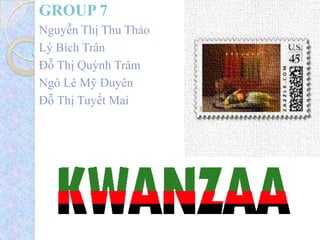
Presentation kwanzaaclass
- 1. GROUP 7 Nguyễn Thị Thu Thảo Lý Bích Trân Đỗ Thị Quỳnh Trâm Ngô Lê Mỹ Duyên Đỗ Thị Tuyết Mai
- 2. WHAT IS KWANZAA ? Unique African-American celebration w/ focus on traditional African values of family, community responsibility, commerce and self-improvement. Time of reaffirming African-American pp, ancestors and culture.
- 3. Reflective holiday_founded by an American teacher in the mid-1960’s during the Civil Rights Movement. Dr Maulana Ron Karenga
- 4. THE DATES First celebrated on Dec 26th 1966 Tradition celebration: Dec 26th – January 1st Focus on Nguza Saba (7 guiding principles) KWANZAA: From Swahili phrase “matunda ya kwanza”, which means “First fruits”
- 5. WHY WAS KWANZAA ESTABLISHED? - Dr Maulana Karenga was disturbed by the 1965 Riots Decided African-Americans need an event to celebrate their differences - Started in 1966 at the height of Civil Rights Movement The first specifically African-American holiday Give Blacks an alternative holiday and an opportunity to celebrate themselves and history
- 7. An important symbol is the wooden candlestick. This candlestick holds 7 candles in a row. The center candle is black. There are 3 red candles on one side There are 3 green candles on the other.
- 8. Day One: The black candle is lit. This is a day of togetherness, sharing feelings. The family gathers and shares how they feel about each other. Many problems are cleared up during this day, simply by talking about them.
- 9. • The black candle signifies UMOJA, which is the central theme of Kwanzaa. UMOJA (UNITY) (oo-MOE-jah) - To strive for and maintain unity in the family, community, nation and race.
- 10. Day Two: A red candle is lit. This is a day of togetherness, sharing traditions. Some people might teach others how to braid hair or how to play an African drum. Others might share a family recipe. Kwanzaa Recipes!
- 11. KUJICHAGULIA (SELF DETERMINATION) (koo-jee-cha-goo-LEE- ah) - To define ourselves, name ourselves, create for ourselves and speak for ourselves.
- 12. Day Three: A green candle is lit. This is day of togetherness, sharing a common goal. Everyone in the family works together to get a chore done - perhaps paint a fence or clean out the garage. What is important is that everyone works together to get the job done.
- 13. UJIMA (COLLECTIVE WORK AND RESPONSIBILITY) (oo-JEE-mah) - To build and maintain our community together and to make our brothers' and sisters' problems our problems and to solve them together.
- 14. Day Four: A red candle is lit. This is a day of togetherness, sharing a family gift. A gift is either made or purchased, something the whole family can enjoy. In years to come, when people see this item, they will remember this Kwanzaa. It can be anything from a house to a cookie cutter.
- 15. UJAMAA (COOPERATIVE ECONOMICS) (oo-JAH-mah) - To build and maintain our own stores, shops and other businesses and to profit together from them.
- 16. Day Five: A green candle is lit. This is a day of togetherness, sharing dreams and hopes. This is an especially good day to ask yourself and each other, "What do you wish to accomplish in the coming new year?"
- 17. NIA (PURPOSE) (nee-AH) - To make as our collective vocation the building and developing of our community in order to restore our people to their traditional greatness.
- 18. Day Six: A red candle is lit. This is a day of togetherness, sharing creativity. First, everyone in the family creates something - a poem, a story, a dance, a painting. In the early evening, the family gathers. Each family member shares what they have created.
- 19. KUUMBA (CREATIVITY) (koo-OOM- bah) - To do always as much as we can, in the way that we can, in order to leave our community more beautiful and beneficial than when we inherited it.
- 20. Day Seven: A green candle is lit. This is a day of togetherness, sharing a feast. The family gathers and enjoys baked ham, roasted yams, collard greens, thick bread, pies and desserts! It is a wonderful feast!
- 21. IMANI (FAITH) (ee-MAH-nee) – To believe with all our hearts in our parents, our teachers, our leaders, our people and the righteousness and victory of our struggle.
- 22. And that is Kwanzaa. This holiday was greatly enjoyed in ancient Africa, just as it is enjoyed today.